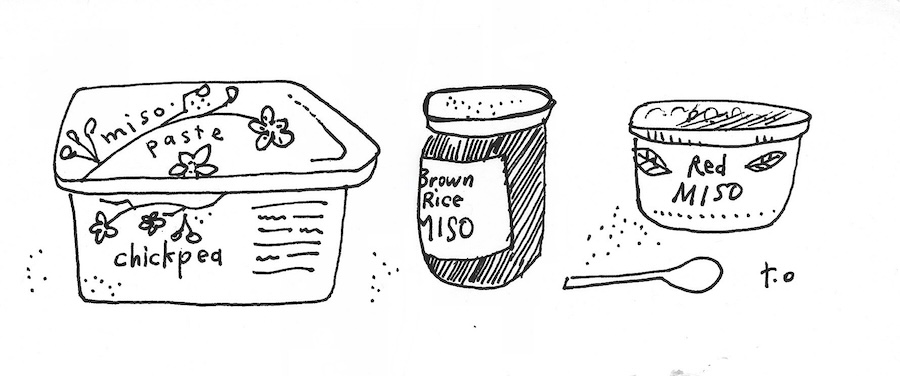By Roberta Bailey
Soybeans are an ancient food with many culinary forms. Most commonly used in the West are miso, a fermented soybean paste; edamame, the fresh green soybeans, served steamed and lightly salted; tofu, a curd made from soymilk; tempeh, the cultured ground soybeans and/or okara left over from making soy milk; and soy milk, a milk product made from cooking ground soybeans in water. In Japan, I became very fond of tofu skin, a thin sheet of tofu that forms on soymilk as it cools, which is then fried or cooked or used as a wrapper like a wonton wrapper.
Maine has local tofu, tempeh, and miso makers. All can be made at home. Most are commercially available.
I am especially fond of fresh soybeans, commonly known as edamame. Easy to grow, they are a sweet and nutty protein source. Many varieties mature all at once, making processing into a one-time effort. A few varieties mature gradually for a longer picking season, if you prefer to eat them over the summer. The pods that are left to dry can be harvested for seed or as dry soybeans for cooked dishes.
A few years ago, I decided to make my own miso. As I was already in the practice of growing soybeans for edamame and I didn’t want to use soybeans of unknown age or history, I decided to grow my own. I chose a black soybean variety recommended for miso and tofu making. I bought pre-made koji, a cultured rice for inoculating the cooked soybeans. The project was quite successful: after 10 months in a crock, the miso was absolutely delicious. Aside from the process, I learned that the homegrown dry soybeans, once soaked and cooked, were slightly sweet and filled with nutty flavor. I knew that homegrown fresh soybeans, or edamame, are much sweeter and more flavorful than the ones served commercially. But I did not think the sweetness persisted through the drying and cooking processes. Most vegetable sugars turn to starches after a few hours or days. Yet another food that is so much better-tasting when grown at home — why was I surprised?
If you want to grow your own, the simplest place to start is with growing a row of soybeans for edamame. The 2-foot upright plants yield abundant pods with two to three soybeans each. Picked once fat, but not starting to yellow and dry, the pods need to be steamed or blanched until they soften, then cooled for shelling. I freeze small bags of shelled edamame to use all winter, often mixed into our rice and sometimes alongside noodles or in a stir fry.
The following recipes are winter-friendly examples of the diversity of soybeans. Delve deeper. The world awaits.
Ginger Kabocha and Tofu

Serves 3-4.
- 14 oz. package of extra-firm tofu
- 2 lbs. kabocha winter squash
- 3 Tbsp. honey
- ⅓ cup tamari
- ½ tsp. crushed red pepper (optional)
- 1-inch piece of fresh ginger root, peeled and finely grated
- 7 Tbsp. vegetable oil
- Salt and pepper
- 3-5 cloves garlic, thinly sliced
- 1 Tbsp. toasted sesame seeds
- 2 scallions, trimmed and thinly sliced
- 2 tsp. lime juice
Drain the tofu, cut it into ½-inch slices. Lay it out between two tea towels and add weight to it to remove some of the moisture. Press for 5-10 minutes.
Heat the oven to 400 F. Cover two baking sheets with parchment or lightly grease them with oil.
Cut the squash into ½-inch cubes. Cut the pressed tofu slices into quarters.
In a small bowl, whisk together the honey, tamari, pepper flakes, ginger, and 4 Tbsp. of the oil.
Combine the garlic slices and the remaining 3 Tbsp. oil in a bowl.
Toss the squash cubes with two-thirds of the marinade. Toss the tofu with the remaining one-third of the marinade.
Spread on the roasting sheets and bake for 15 minutes. Using a metal spatula, turn the squash and tofu. Then drizzle the garlic slices and oil over all. Return the pans to the oven and roast until the squash is soft and the tofu is dark. Serve from the pans or arrange on a serving dish. Sprinkle with sesame seeds and scallions, and drizzle with the lime juice.
(Eggplant can be substituted for the squash. Add lots of black pepper.)
Miso Caramel Popcorn with Black Sesame Seeds
Serves 2-3. Makes approximately 8 cups.
- 2 Tbsp. neutral oil
- ½ cup popcorn kernels
- ⅔ cup honey
- 3 Tbsp. butter or oil
- ½ tsp. baking soda
- 2 Tbsp. red or white miso
- 1 Tbsp. black (or white) sesame seeds
Heat the oil in a heavy pan and pop the popcorn. Dump it into an over-sized lightly oiled bowl. Wipe out your popping pot then add the honey. Heat over medium heat, stirring constantly, until the boiling honey caramelizes, about 8-10 minutes. Add the butter or oil. Cook for 1-2 minutes over low heat. Remove from heat and add the miso and baking soda. Whisk rapidly. Quickly pour it over the popcorn and toss to coat. Spread the popcorn on a baking sheet lined with parchment paper and sprinkle with sesame seeds.
Let cool and serve in bowls. If it seems too moist, bake in a 300 F oven for 10-15 minutes.
Tempeh and Squash Tikka Masala

- 8 oz. tempeh
- 1 cup ½-inch cubes of squash or carrot
- ½ cup unsweetened plain yogurt
- 2 tsp. apple cider vinegar
- 1 tsp. ground cumin
- 1 tsp. ground ginger
- 1 tsp. garam masala
- ½ tsp. sea salt
Sauce:
- 1 Tbsp. coconut or neutral oil
- 1 medium onion, diced
- 3-4 cloves garlic, minced
- 1-inch piece of fresh ginger root
- 1 tsp. garam masala
- 1 tsp. chili powder
- ½ tsp. sea salt
- ¼ tsp. turmeric
- 1 cup tomato sauce
- 1 cup full-fat coconut milk
- 2 cups frozen peas, or half shelled edamame
- ½ cup fresh chopped cilantro or parsley
Plus:
- Rice for serving
- Hot sauce (optional)
Mix the yogurt, vinegar, cumin, ground ginger, garam masala, and sea salt. Cube the tempeh and squash or carrot. Toss with the yogurt marinade and chill for one hour.
Once the tempeh has marinaded, prepare the sauce. In a large skillet, heat the coconut or vegetable oil. Add the onion, ginger, and garlic, and saute until translucent and fragrant, about 5 minutes. Add the remaining spices and stir well. Add the tomato sauce, coconut milk, and the tempeh-squash mixture. Simmer for 15-20 minutes, until the squash cubes are tender. Add the frozen peas. Heat until just thawed. Serve over rice. Top with cilantro or parsley. For extra heat, add some cayenne flakes to the spice mixture, or serve with sriracha or hot sauce.
Miso Edamame Slaw
Serves 4-6.
- 4 cups thinly sliced combination of any of these vegetables: carrot, celery, bell pepper, radish, cucumber, snow peas
- 2 cups finely shredded Chinese cabbage
- 1 cup shelled edamame
- 1 cup chopped salted peanuts (optional), or ¼-½ cup toasted sesame seeds
- 1 cup thinly sliced scallions, tops and stalks
- ½-1 cup chopped cilantro (optional)
- 1 cup miso dressing (below)
Protein option: 1 lb. chicken breast or thighs (brushed with a 1:1 ratio of tamari and honey, then grilled)
Dressing:
- 1 Tbsp. minced fresh ginger root
- 1 medium clove garlic, minced
- 2 Tbsp. Tahini
- 2 Tbsp. white miso
- 1 Tbsp. honey
- ¼ cup rice vinegar
- 2 Tbsp. toasted sesame seed oil
- 2 Tbsp. neutral oil
- Salt and sriracha as desired
Combine all the dressing ingredients in a blender, running until smooth, or whisk vigorously. Taste and adjust to your heat preference.
Mix the salad ingredients, holding back some peanuts, or sesame seeds, and cilantro and scallions for a garnished top. Start by tossing with half the dressing, then add to taste. Season with salt and pepper if desired. Eat within a few hours.
Classic Miso Soup

I add bonito flakes (or Hondashi) to my soup, as that is what I learned in Japan, where the miso soup had a deep rich umami flavor that I had never tasted in the United States.
- 4-6 cups water
- 1 4-inch piece of kombu/dried kelp
- 1-2 Tbsp. bonito flakes, or Hondashi to taste (about 1 tsp.)
- 1 cup onion, cut lengthwise into crescent-shaped slivers
- 4-8 oz. tofu, cubed
- 1-2 cups greens (spinach, shredded kale, bok choy, or other tasty greens)
- 3-5 Tbsp. miso paste (I like a mixture of white or chickpea miso, and a red or dark miso.)
- ¼ cup chopped scallions (optional)
Add 1 cup water to the soup pot and bring to boil. Add the kombu and onions. Simmer for 5 minutes. Remove the kombu. Add the bonito or Hondashi. Add the tofu and greens. Simmer until just tender.
With a small soup bowl, remove 1 cup of broth from the pot. Stir the miso into the hot broth, then return it to the miso soup pot. Do not boil the miso. Always add it at the end. Add more miso, to taste.
Serve with scallions as a garnish, if desired.
Soybean and Coconut Milk Dip (Tau Jiew Lon)
Use as a condiment for fresh vegetables or meat, or as a dip or spread.

- 2 ½ cups coconut milk
- 3-4 shallots, minced
- ½ cup salted soybeans
- 2 oz. wild-caught raw shrimp (about 5-6 shrimp)
- 2 oz. raw pork, finely chopped (¼ cup)
- 1-2 tsp. honey
- 1 egg
- Chili flakes to taste
- Fresh cilantro, chopped, for garnish
Bring the coconut milk to a boil. Add the shallots, soybeans, shrimp, and pork. Mix well, then stir in the egg, stirring constantly. Cook at a slow boil until slightly reduced, then add the honey and chili flakes. Simmer for 5 minutes. Cool to serve. Garnish with cilantro.
This article originally appeared in the winter 2024-2025 issue of The Maine Organic Farmer & Gardener.
